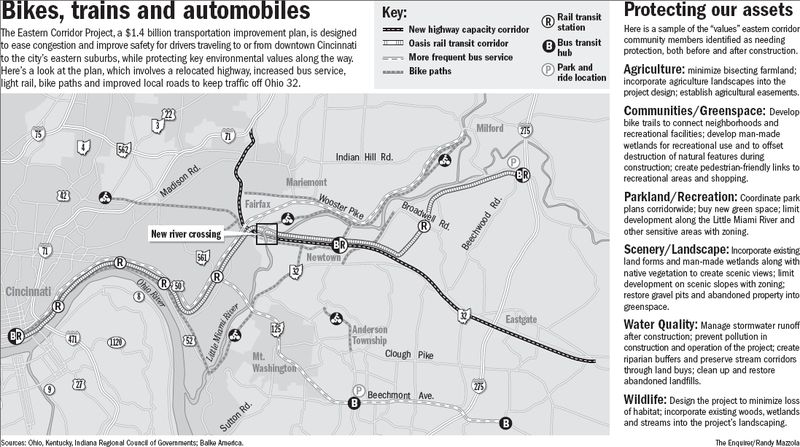
The above graphic was published in the August 22, 2005 Cincinnati Enquirer.
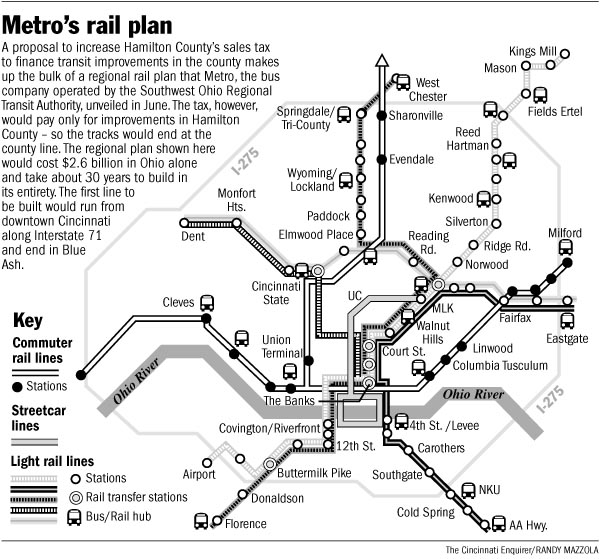
Although at this point far from comprehensive, I plan to continuallyimprove this page with more historical information and archive newsstories as they appear. Here is a brief synopsis of thelast fifty years:
1950's: The last ofCincinnati'sstreet car lines are
abandoned andreplaced by diesel bus service.
Track remains under many of Cincinnati's streets.
1960's: High speedcommuterrail proposed for for the median of the
Northeast Expressway (Interstate 71).
1970's: In response tothe energycrisis commuter rail lines are proposed.
One proposal called for the C&O CheviotHill line to feed commuter
trains into the Central Parkway Subway. The Cheviot Hill line was
abandoned and dismanted in the late 1980's.
1980's: No proposals.
1990's: Plans for aregionalrail transit system are developed and publicized.
Test borings are made for a mile-long tunnel under Mt.Auburn.
2000's: In November 2002the"Metro Moves" campaign was defeated nearly
2-1 in a county-wide vote. The Riverfront Transit Center was completed
under 2nd St. in 2002. It might serve as the downtown
terminus for riverside rail lines to Milford and Lawrenceburg.
Milford Light Rail?
The soon to be completed Eastern Corridor study shows promise for construction of Cincinnati's first modern rail transit line. This line will parallel the Ohio River on existing but rarely used freight tracks several miles east of downtown before turning northeast along the Great Miami River. Although few potential riders live within walking distance of the proposed suburban stations, the line will attract significant bus tranfers and park-and-rides. Until construction of the proposed Wasson Rd. light rail line, which will travel on existing freight line through Hyde Park en route to Xavier University and the proposed I-71 light rail line, the Milford line will serve primarily downtown commuters. The proposed expressway to be built in conjunction with the Milford rail line will by contrast provide a connection between existing far eastern suburbs and Cincinnati's northeastern suburbs.
Although the proposed Milford Line will not serve any of the city's most densely populated neighborhoods, and few potential riders live within walking distance of the proposed line's suburban stations, it should attract significant bus tranfers and suburban park-and-riders. The line should be able to be built relatively cheaply, as much right-of-way is already in place and no tunneling proposed. At least part of the initial segment would be single-tracked. Existing right-of-way includes the Riverfront Transit Center, which will likely serve as the line's downtown terminus.

The above graphic was published in the August 22, 2005 Cincinnati Enquirer.
Road, rail plan nears decision
$1.4B project includes controversial bridgeBy Dan Klepal
Enquirer staff writer
Related PDF File
http://news.enquirer.com/assets/AB7327822.PDF
FEATURES OF THE EASTERN CORRIDOR PROJECT
Light rail: A passenger train to be build on the "Oasis" line, running from Milford to the Cincinnati riverfront, connecting to the Transit Center near the Underground Railroad Freedom Center. Cost: $411 million.Ohio 32: Expanded to four lanes and realigned, with a new bridge crossing the Little Miami River east of Newtown, connecting to Red Bank Road. Cost: $506 million
Bus: New bus hubs and new service routes. Cost: $50 million.
Local roads: Improvements to local roads and intersections to keep local drivers off Ohio 32. This also includes building more park-and-ride lots and bike trails. Cost: $45 million.
New bridge: Designed for use by cars, buses, trains and bikes. Cost: included with Ohio 32 upgrades.
Environment: Protect green space and hillsides, protect or build new wetlands and riverbank zones along the river, connect green areas and historic sites with bike paths. Pay for it all with new tax dollars coming into communities from the development spurred by the upgraded transportation network.
[...]
The project calls for the region's first light-rail system, the widening and relocation of Ohio 32, improvements to roads and intersections, a new bridge over the Little Miami River, along with vastly increased bus routes and bike trails.
Transportation planners say the plan was devised only after years of meeting with people in the 17 communities that make up the corridor, and incorporating their ideas about protecting the environment, farms and the quality of life in their neighborhoods - not just from the new highway construction, but from the development that will surely follow.
But many environmentalists aren't buying the green spin. The real goal of the project, they think, is to build a major new highway to spur development, and plans for expensive light rail and environmental projects are speculative, at best.
"That river is the Central Park of Ohio, and they're willing to trash it so people can get to work faster for a couple of years ... until the highway fills up again," said Mike Fremont, president emeritus of Rivers Unlimited and co-founder of the national American Rivers organization. "Everything else is just pretty pictures. You can put rouge on a pig, but it's still a pig."
Environmentalists have pinned their hopes for tripping up the project on the federal protections afforded the Little Miami River by its status in the National Wild and Scenic River program, which is intended to limit development that would significantly degrade the river. The National Park Service, which runs the program, has weighed in on their side.
But the Federal Highway Administration has final say, and it is expected to make a ruling on the project's plans soon, perhaps this week.
A thumbs-up means planners can move on to more detailed designs and cost estimates; a thumbs-down means the project is dead.
The federal agency could also go somewhere in between, asking planners to rethink some of their ideas, like building a new bridge over the Little Miami.
A long road
Planners first identified the Eastern Corridor as a transportation trouble spot in the late 1960s.
Then, as now, they were worried about growing population, busy U.S. 50 running through the heart of Mariemont, an ever-more crowded Ohio 32, and better east-west connections for delivery trucks and commuters to spur development and make the drive shorter for everyone.
That original plan called for expanding and relocating U.S. 50 so it would run parallel to the Little Miami River for miles, and just 50 feet away from it in some spots. Then, as now, many environmentalists hated the idea, saying studies in support of the project minimized environmental damage and overestimated benefits.
The Federal Highway Administration raised several issues with the plan in 1972, which had the effect of stalling it for decades. The project was revived - briefly - in the mid-1990s, but was eventually killed because of environmental concerns. A few years later, the Eastern Corridor Project was born.
[...]
A social contract
Some of the values identified include:
Preserving farms by not allowing the highway to bisect them, and by granting agriculture easements.
Creating or restoring wetlands and riverbank zones along the river to filter pollution and provide living space for birds and wildlife.
Connecting parks, recreational areas and historic sites with hike and bike paths to create a green space network, and so locals don't have to drive to those areas.
Protecting hillsides, the river, the aquifer and other important environmental features through zoning.
Landscaping with natural vegetation and natural landforms; saving "scenic vistas" from development, again through zoning.
Cleaning abandoned landfills to beautify the region and preserve water quality.
Planners say the communities in the Eastern Corridor have a sort-of social contract to coordinate zoning issues and reinvest taxes from development into conservation.
"If you don't have money coming in, you don't have any way to buy land that you want protected," said Rick Record, project manager for engineering consultant Balke American.
None of the project's major critics - the Sierra Club, Rivers Unlimited and Little Miami Inc. - participated in any committee that came up with those ideas, and others.
Eric Partee, executive director of Little Miami Inc., said the groups decided against it because the process presumed a new highway and bridge crossing over the river.
"We're not interested in having the highway built and then cleaning up other sections of the river," he said. "So we disagreed with the premise under which the committees were established."
That's too bad, Record said, because their input was sought. In 15 years, the corridor's population is expected to soar to 200,000, with another 90,000 working in the region - an increase of about 19 percent over today.
50 million miles
"This plan will reduce miles driven by 50 million per year. What will that do for the environment?" said Mark Policinski, executive director of the Ohio-Kentucky-Indiana Regional Council of Governments, the area's transportation planning agency. "We're trying to make the environment better by investing in a transportation solution. We're looking at water quality impacts all up and down the corridor, not just the impact of one bridge crossing."
Partee, Fremont and others, like Marilyn Wall of the Sierra Club, say the best way to do that is to build light rail, expand and improve bus service, and make improvements to local roads first.
"If the goal is to get rid of congestion, transit can do that," Partee said. "Let's do that first and see what happens. But dragging all that traffic from Eastgate through the valley is not going to solve our problems.
"You think it's bad now, just wait."
http://news.enquirer.com/apps/pbcs.dll/article?AID=/20050822/NEWS01/508220342
###
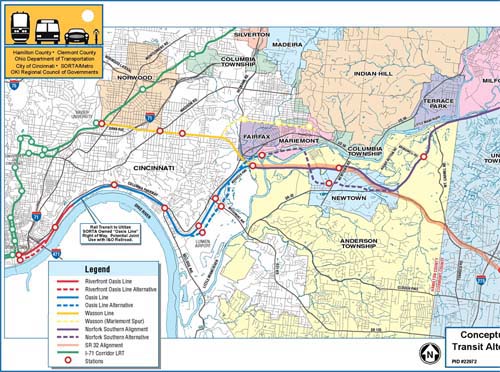
2004 plan for Milford commuter rail line. ClickHere for a larger
version of this graphic.
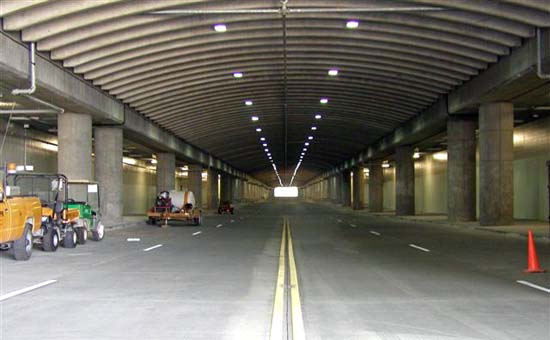
The RiverfrontTransit Center, pictured above, is planned to serve as the
terminus for two commuter lines and possibly replaceAmtrak's lonely
platform at Union Terminal.

A detail of the Milford line's approach to the downtownTransit Center. Trains will approach the transit center, at leastin part, on track embedded in Pete Rose Way. In some proposals aviaduct will lift trains above Pete Rose Way just east of the Broadwayintersection. The dotted red line shows the cheaper and lessconvenientdowntown approach via the unused Oasis Line through BicentennialCommonsand Sawyer Point. In this scenario trains would terminate on theriverbank at the intersection of Mehring Way and Broadway. ClickHere for a larger version of the above graphic.

The abandoned "Oasis" line through Sawyer Point, asviewedfrom the L&N Bridge.
Freight trains last used this line in 1988.

A view of Columbia Parkway (center) and Eastern Avenue(right) from Eden Park.
The unused Oasis line runs just to the left of EasternAve.
[Photo courtesy Jayson Blaine]
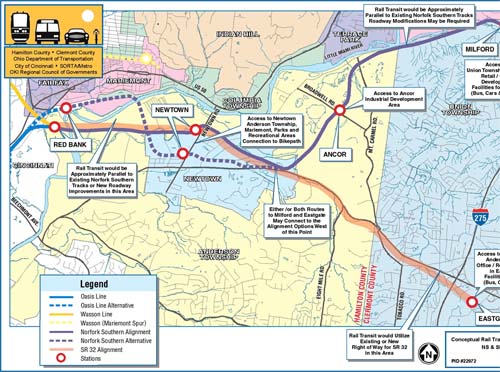
A detail of the line's possible routing through Newtown.
ClickHere for a larger version of this graphic.
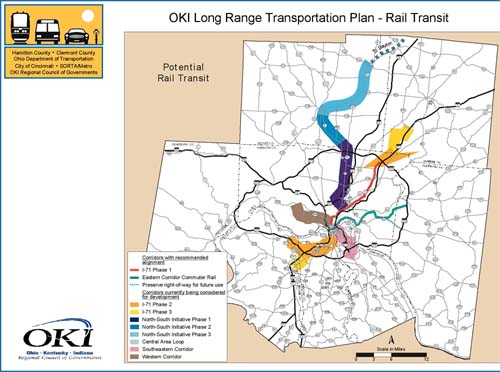
ClickHere for a larger version of this graphic.
Light Rail & Commuter Rail News Archive
August 8, 2005
Garages could help fund light rail
Banks might be catalyst for $450M line to Milford
Lucy May
Senior Staff Reporter
Ohio and Hamilton County officials are working to parlay $24.5 million in federal money earmarked for riverfront parking into funding for what would be the region's first light rail line.
Planning is in the early stages. But the potential is so strong that Ohio Department of Transportation Director Gordon Proctor recently declared the project the region's best shot at building light rail.
"The tracks are there," he said after an Aug. 1 meeting of the Hamilton County Transportation Improvement Dis trict. "And it appears there will be even more of a destination on the riverfront."
The whole plan hinges on the success of The Banks, the riverfront development that will consist of as much as 1.4 million square feet of retail, residential and office space between Paul Brown Stadium and Great American Ball Park.
County officials and their development team, The Banks Development Co., need the federal money to help build the $55 million in parking garages planned to lift the development out of the flood plain and replace the surface parking lots that are there now.
Hamilton County, the Reds and the Bengals all share in the revenue generated by the parking lots between the football stadium and ballpark. And county officials don't want to give up that revenue, which helps pay down the debt that Hamilton County issued to build the sports facilities.
But under federal rules, the county and teams cannot keep any revenue generated by garages built with the federal funds.
So county and state officials are working on a plan that would segregate a percentage of revenue generated by the garages, based on the percentage of the total project cost that is paid for using the federal dollars.
That revenue could then be used to help fund a $450 million light rail line that eventually could stretch 18 miles -- from The Banks all the way to Milford.
"They've been trying to figure out how to physically construct the building and construct the finances so that can happen," Proctor said. "We're trying to create firewalls for where this money is spent."
As complex as that will be, it is possible, said Diana Martin, planning administrator for ODOT's District Eight office.
"As long as we structure it financially appropriately, yes we can (make this work)," she said.
If the funding can be structured as planned, the money would represent a huge boost to the $1 billion Eastern Corridor plan to improve gridlock throughout the eastern part of Greater Cincinnati.
And Hamilton County commissioners view that as one of the most important elements in The Banks project, said Commissioner Todd Portune.
"One of the reasons that we more or less took charge of the project was because we, as a body, are very interested in advancing all these policy objectives," Portune said, adding that the plan also could incorporate a transit link to Western Hamilton County and even a high-speed rail line that connects Cincinnati with Chicago and other Midwestern cities. "The whole Eastern Corridor project is very, very important to Hamilton County."
Started in 1996, the Eastern Corridor project encompasses a series of transit and road improvements that stretch through Cincinnati, Hamilton County, Clermont County and even into Campbell County in Northern Kentucky.
With so many communities involved, political leaders directed planners to find a way to fund the plan without raising taxes, said Steve Wharton, deputy project manager.
"So you're looking for increments of growth you can capture," Wharton said.
Planners haven't yet calculated how much parking revenue the federally funded portion of The Banks garages could generate for rail, Wharton said. But the hope is that the revenue would be enough to support bonds or other financing for the project.
Transportation planners are in early discussions with developers about creating a plan for The Banks that allows for the possibility of rail lines along the central riverfront and transit stops along the way.
Wharton said transportation planners have discussed building an initial rail line from the riverfront out along Columbia Parkway to Linwood or Lunken Airport. Tracks along the riverfront Oasis Line likely wouldn't be used for the project, he said. But the right of way for those tracks already is publicly owned, which is key.
Ideally, the initial line would then spawn economic development that would generate taxes. Planners hope political leaders will agree to dedicate some portion of those increased taxes to help pay to extend the rail line and fund other infrastructure.
The cost of the 18-mile line is estimated to be anywhere from $400 million to $450 million, Wharton said. That assumes double tracks along the line, he said, but rail construction could start with single tracks.
"Because you're phasing this in, you're not in danger of overcommitting your resources," Wharton said. "This plan really lets the public sector anticipate and stipulate where private investment could be attracted."
The key will be starting with The Banks.
The team working on a development agreement didn't have much to say.
"It is premature for us to speak on the rail," said Melissa Casto, vice president in the office of the president at Corporex Cos., which along with Vandercar Holdings makes up The Banks Development Co. "We have not studied the plan. We believe it will be good to have."
But Portune said developers have made it clear to Hamilton County officials that a strong transit component is crucial.
"It makes it a much more viable and exciting project," he said.
###
No money for light rail
Cincinnati Post staff report
Light rail is no longer a priority of Greater Cincinnati transportation planners because money can't be found to pay the estimated $2.6 billion such a rapid transit system would cost.
The Ohio-Kentucky-Indiana Regional Council of Governments, in charge of the area's transportation planning, excluded most rail projects when it updated its 30-year transportation plan Thursday.
"We cannot recommend a regional rail system plan because of financial reasons," said Robert Koehler, OKI's transportation planning manager.
"One day we hope to get there. It's a great idea, but we can't finance it right now."
Plans developed several years ago called for an extensive light rail system through northern parts of Boone, Kenton and Campbell counties in Northern Kentucky and through eastern and northern sections of Hamilton County to Butler and Warren counties.
OKI's updated transportation plan retains only two parts of the original rail plan and neither is actually light rail -- a streetcar route that would connect downtown Cincinnati, Covington and Newport and a diesel train passenger route from downtown Cincinnati through eastern Hamilton County to the junction of U.S. 50 and Interstate-275 in the Milford area.
Streetcars in the $132 million streetcar system would be electric-powered from overhead lines and run on rails embedded in existing streets and bridges. The streetcars would share the roadway with cars.
"It has a relatively low cost and the South Bank Shuttle (a current bus service that links Northern Kentucky and downtown Cincinnati) is evidence that it could be popular," said Koehler, who said he could not predict if or when such a system might be built.
The $265 million, 18-mile diesel train passenger route would run on existing Oasis line railroad tracks, but would have to share them with freight trains.
"It would run at peak commuting hours, but there's still a lot of work to be done before it could happen," said Koehler.
Although light rail is no longer a priority of OKI, the group's updated transportation plan continues to"support" the idea.
OKI is also recommending the preservation or acquisition of rail right-of-way in a half-dozen areas -- most of them along Interstates 71 and 75 -- in case money becomes available for light rail in the future.
"Times change, ideas change," said Koehler. "Rail is worth keeping on the burner."
With or without light rail, "we're losing the (highway) congestion battle either way we go," lamented Koehler.
Noting that Greater Cincinnati's population is expected to increase 20 percent from 1.89 million in 2000 to 2.27 million in 2030, he said that"demands on roads and transit will continue to be significant."
To try to keep up with transportation demands, OKI estimates that $7.54 billion in federal, state and local sources will be available from now through 2030 for transportation improvements in the area -- $5.92 billion in southwest Ohio and $1.62 billion in Northern Kentucky.
Of that, $3.68 billion -- about $2.8 billion in southwest Ohio and some $850 million in Northern Kentucky -- is expected to be spent on 116 highway projects that include 466 miles of new lanes and 450 miles of reconstructed lanes.
OKI estimates that another $10 billion worth of projects are needed, but can't be implemented because funding isn't available.
"Obviously, we don't have enough money, so we've got to prioritize," said Koehler.
###
Bridge could handle light rail
------------------------------------------------------------------------
Publication Date: 05-10-2004
Cincinnati Post staff report
Wednesday, November 6,2002
Issue 7: Light rail
By James Pilcher
The Cincinnati Enquirer
Issue 7, which would have raised the county sales-tax rate by ahalf-centto help
pay for a $2.7 billion transportation plan put forth by the SouthwestOhio
Regional Transit Authority, lost by a ratio of more than 2-to-1.
The centerpiece of that MetroMoves plan,
and the cause of most of the controversy,
was a 60-mile, $2.6 billion light-rail system
that would have included five lines
through the county.
"What is clear in this is that the supporters
of Issue 7 seriously underestimated the
ability of Hamilton County voters to assess
just how risky this plan was," said Stephan
Louis, a Pleasant Ridge medical-supplies
salesman who led the campaign against
Issue 7.
With 100 percent of precincts reporting,
161,166 votes, or 68.4 percent, were
against the tax and 96,469 voters, or 31.6
percent, said yes - a difference of 64,697
votes.
But despite the landslide rejection, officials
of Metro - which runs the county's bus
system - said they were committed to the
plan and to the concept of light rail,
although they said no decisions had been
made about what would happen next.
"If you look back 3-4 years ago, the issue
of expanded transportation or the new
technology of light rail was not in
anybody's thoughts," said Metro general
manager and chief executive officer Paul
Jablonski.
"At some point in the future, the plan will become reality, and it'sjusta matter of
when. The time is obviously not today, though."
Before the election, transit officials said they expected the sales-taxhike to raise
about $60 million and pay for about 25 percent of the plan. The planthencalled
for the federal government to cover half the cost and the state tocover25
percent.
The proposal includes both the light-rail system, and more than $100millionin
improvements and expansions to the present bus system.
Area transportation planners hoped that, if built, the Hamilton Countysystem
would have been the backbone of a regional rail plan that could extendinto
Warren, Butler and Clermont counties and into Northern Kentucky's three
counties - Campbell, Kenton and Boone.
During a contentious campaign that saw pro-transit advocates faroutspent
anti-transit forces, which included many conservative electedofficials,local transit
officials said the only thing keeping light rail from coming to theareawas the lack
of a local funding source.
They pointed to their last proposal to the federal government for alight-railline
along Interstate 71, which received a passing grade on all aspects oftheplan
except local funding from the Federal Transit Administration.
That forced the agency to give a "not recommended" rating overall.
A project must be recommended by the federal agency before it is takento
Congress for funding.
Local transit officials have said that since Congress is renewing afive-year
transportation authorization bill next year, this is the time to securethat local
funding to show the area is serious about improving mass transit,lowering
congestion and improving air quality.
Advocates have spent more than $500,000 on their campaign, saying theplan
would also boost area development as well as provide for bettertransportationfor
the physically and financially challenged.
Yet there was a very vocal campaign against the issue. Several areaelected
officials, including U.S. Rep. Steve Chabot, R-Cincinnati, lined upagainstIssue 7.
These opponents argue that light rail would not be effective inreducingtraffic
and air pollution, and that the costs of such a system would quicklyexceedthe
$2.6 billion figure. Both sides had appeared at numerous public debatesin the
weeks leading up to Election Day, accusing each other of distorting thesame set
of facts to their own advantage and repeatedly making the samearguments.
Metro ballot issue asks for boost in sales tax
Forthe first time in 22years, Hamilton County voters will be asked to tax themselves tofinance the Tristate's largest public transit agency. The Nov. 5 vote,which is likely to trigger a sharp debate over traffic and airpollution, could radically reshape transportation here by adding alight-rail system.
TheSouthwest OhioRegional Transit Authority's board of directors voted 9-0 Tuesday toput a half-cent Hamilton County sales tax increase on the fall ballot.
Thetax hike would paythe local contribution toward the $2.7 billion MetroMoves plan, whichincludes other major transit improvements.
Metrogeneral manager andchief executive officer Paul Jablonski warned the board before it votedthat the hard part of convincing voters of the need for the expansion —and persuading them to agree to the tax — was still to come.
“You'regoing to hearthat for this amount of money, we could buy everybody in the city a newAudi,” Mr. Jablonski said. “But this is still the right thing to do.”
Areaofficials and political experts agreed a new transit tax would be ahard sell.
That'sbecause it comesrelatively soon after a 1996 stadium initiative that raised the countysales tax by a half-cent — and the ill-will created toward that projectby multimillion-dollar cost overruns at Paul Brown Stadium.
Theproposal also will beon the ballot with several other tax initiatives, including a $480million Cincinnati Public Schools bond issue to help repair or replace66 buildings.
“They'regoing to have todraw a constituency from both the city and the county, and it is goingto be hard to create a voter base from such a disparate group,” saidGene Beaupre, who teaches urban administration and campaign politics atXavier University and who has previously run levy campaigns. “And thenyou need to reach the swing voters, and who knows who they might be atthis point.
“There areso manydifferent arguments for and against this thing that it's going to bedifficult to sell it to people on a gut level, which is what it willtake to overcome past history.”
The boardalso chose tokeep its current operational funding in place, with any new funds topay only for MetroMoves construction and operation.
Metroreceives 0.3percentage points of Cincinnati's 2.1 percent city earnings tax onwhoever works or lives inside the city. If Metro's tax hike isapproved, Hamilton County's sales tax would rise to 6.5 percent.
The finalversion ofMetroMoves, unveiled in late June, includes a five-line, 65-mile lightrail system that would be built over 30 years, with a route extendingfrom Blue Ash to downtown along Interstate 71 slated to be built first.It also includes a streetcar line between downtown and the Universityof Cincinnati/Pill Hill area, and a $100 million restructuring of thebus service to include more cross-town routes and transit hubsthroughout the city and county.
While theproposal alsoincludes extensions into Butler, Warren and Clermont counties in Ohioand two lines into Northern Kentucky (one along I-71/75 and anotheralong I-471), those lines would not be funded by the proposed tax hike.It would be up to those individual counties to someday join the system.
Theproposed sales taxhike would raise about $61 million annually beginning in January 2003,enough to cover the local share of construction and operations.
Metroofficials arecounting on federal funds to cover half the cost of the light railsystem, and on state funds for another 25 percent.
Ifapproved by voters,the sales tax hike would finance the first major renovation andimprovement to Metro, the county bus service, since it was created in1972.
Theproposal is the firsttime since 1980 that the transit authority has gone to the public formore money. Only one of its previous three attempts was successful —the 1972 vote in Cincinnati that approved the current earnings tax.
The agencyfailed in 1979and again in 1980 to get its primary funding converted from theearnings tax to a sales tax and expand its route structure.
Opponentsof the proposalvowed to fight the issue, although they said they weren't to discussspecifics on how much money they have raised.
“We'llcompare it togetting a shiny ... beautiful Mercedes Benz and then seeing the billfor buying it, maintaining it and having only one person riding in it,”said Stephan Louis, a Pleasant Ridge medical supplies salesman andchairman of the main opposition group, Alternatives to Light RailTransit.
Metroofficials, who willhave to rely on private citizens to conduct any outside levy campaign,acknowledge that they're in for a fight. One problem is that fewelected officials in the area have stood up in favor of it, with farmore voicing opposition to it, including Hamilton County CommissionerJohn Dowlin. The cities of Deer Park and Norwood also have rejected theconcept in separate resolutions.
CincinnatiMayor CharlieLuken has also been critical of Metro's ad campaign, saying the spotswere an illegal use of public funds for a potential levy campaign. ButMr. Luken has stopped short of criticizing the MetroMoves plan, andsaid Monday he wanted to study the proposal further.
“We feelthat we havepeople who are ready to come out publicly to help us,” said transitboard chairman Peter D. Gomsak Jr., declining to offer specific names.
Mr. Gomsakalso deniedthat the transit board — which includes city and county representatives— expects to lose the ballot. In other cities, transit officials havetaken two or more proposals to voters before finally gaining approval.
Mr. Gomsaksaid that iflocal funding is not secured by early next year, the Tristate couldlose out on federal funds for five years or more.
“This isnot just some trial balloon,” he said.
MetroMoves: What will itmean to area?
Officials with theSouthwest Ohio Regional Transit Authority today could recommend to theagency's board of directors that a sales tax levy be placed on theNovember ballot to pay for the recently unveiled MetroMoves plan thatincludes a light rail system and improved bus service.
The board isexpected to vote on the proposal, meaning Hamilton County voters couldbe given the choice in November.
Here are somecommonly asked questions about the issue.
What isMetroMoves and what does it include?
MetroMoves is thelong-range strategic plan put together by Metro, the bus service. Itincludes a major expansion of the city's bus service that would createmore east-west lines.
It also includes alightrail plan that would include five lines that would run east-west fromwestern Hamilton County to the Eastgate area and along Interstates 71and 75, and a street car line from downtown along Vine Street throughOver-the-Rhine to the University of Cincinnati and Mount Auburn,including the city's hospital district. The plan calls for the railsystem to be built over 30 years, with a line connecting downtown toBlue Ash along I-71 to be built first.
How much willit cost, and who will pay for it?
The currentestimate forthe Hamilton County portion of the light rail system is $2.6 billion —the bus improvements would cost $100 million.
The long-term lightrailplan includes two lines into Northern Kentucky, and extensions of thetwo northern lines into Butler and Warren counties.
The estimated totalfor the entire system is more than $4 billion.
Metro officials saytheyare counting on the federal government to pay for half, with that moneyprimarily coming from federal gasoline excise taxes. They are alsocounting on 25 percent of the total from the state, although stateofficials have said that funds at that level could be scarce, withlocal funding covering the final 25 percent.
What are theoptions for the local share?
The SORTA board hastheauthority to issue bonds or seek tax increases by election. Agencyofficials have previously said that they are considering a half-centincrease to the Hamilton County sales tax (currently 6 percent) tocover the local portion of the total.
The board could puttwoinitiatives on the ballot — one for light rail and one for the busimprovements — but Metro officials have previously said that thepreferred option is to do it in one.
Another possibilityisthat the agency could change the way it generates local revenue (Metrogets three-tenths of 1 percent of the 2.1 percent Cincinnati earningstax levied on each wage-earner in the city.) Metro could seek more thana half-cent to eliminate that tax and pay for MetroMoves and its annualoperations.
Why is thetransit board considering this now?
The only thingpreventingthe light rail project from being approved by the Federal TransitAdministration is a lack of local funding. Approval from the FTA isnecessary before Congress can appropriate money for any transitproject.
Congress is abouttobegin deliberating the reauthorization of the main law that funds majortransportation projects nationally, and this appropriation law is onlyrenewed about every five years or so.
So if a localfundingsource were not secured in time for this round of federal money, Metroofficials have said, then the project would probably have to waitanother five years or so.
— James Pilcher
###
Metro plans $100M-plus expansion
In anexpansion aimed atfollowing the growth of homes and jobs in suburban Cincinnati, Metrotoday will unveil a 10-year plan to dramatically increase regionaltransit service.
The plan emphasizeseast-west bus routes, and includes 28 new hubs (small transit stations)from Harrison and Cleves on the west, to Loveland and Eastgate to theeast.
Bus routeseventually would tie in with other forms of public transit, including aproposed light-rail system.
Hub construction isestimated to cost $108 million to $192 million, with 90 percent comingfrom state and federal sources. Then, annual operating costs would beabout $97 million, compared to annual operating costs of $67.8 millionnow.
Both the Metro planandlight rail would rely heavily on state and federal funding, butultimately, both are likely to require local money, too.
“That's money we'dhaveto find somehow,” Metro spokeswoman Sallie Hilvers said Monday,alluding to a possible local tax.
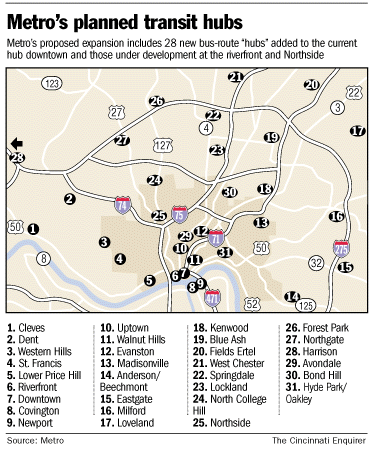 |
Today'sannouncement atthe Westin Hotel downtown will draw about 300 busi ness, political andcivic representatives, Metro officials say.
Metro makes 24million passenger trips per year but is still concentrated within thecity of Cincinnati.
“It would improveforeverybody,” said Harrison Mayor Daniel Gieringer. “With the waygambling's growing (in nearby southeast Indiana), Harrison's growth andnew businesses, if they put a hub out here, they'd make money off it.”
According torecentlyreleased U.S. Census figures, Cincinnati lost 9.1 percent of itspopulation from 1990. Greater Cincinnatians are moving — but not far.
Butler, Warren andClermont counties continue to be among the fastest-growing in Ohio, andtax abatements and other incentives have drawn thousands of jobs fromthe inner city to the suburbs.
But too often,expansion proponents say, you can't get there from here.
This isn't news toMylus Edwards, 33, of College Hill, owner of Unforgettable cleaningservice.
“I've had jobs inBlueAsh, and my car broke down,” Mr. Edwards said, getting out of hisrental car downtown on Monday. “I had to rent a car. Lot of good jobsout there, so I think it's a good idea.”
The plan to beunveiledtoday is the culmination of a year's worth of public forums; but howfar the proposal reaches will depend on further public input and,ultimately, public funding.
“People are goingto havemore options to driving your car to make the connections you need tomake,” Ms. Hilvers said.
Metro, a nonprofitpublicservice of the Southwest Ohio Regional Transit Authority, runs 439buses about 13 million miles annually. It also provides about 11,000rides for students to and from Cincinnati schools and parochial juniorand senior high schools.
When asked if thepublicwould be receptive to financing a portion of the project, Randy Moss,47, of Anderson Township, laughed.
###
Local Transit Planning Links:
www.oki.orgRegionalCouncil of Governments -- regional transportation planning.
www.sorta.com Cincinnati bus system.
www.easterncorridor.com Discussion of the proposed Milford commuter rail line.